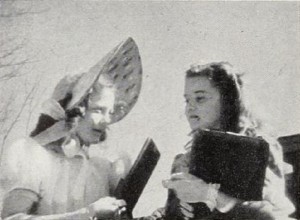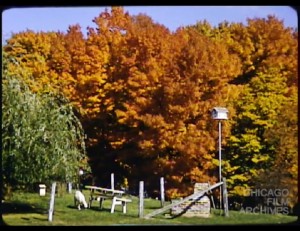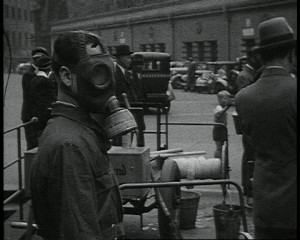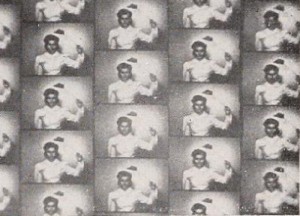
"The 246 year old Voorlezer House, believed to be the oldest elementary school building still standing in the United States, is located on Staten Island, N. Y. It has long been an interesting landmark, but it is now preserved for posterity in Kodachrome by the master hand of Frank E. Gunnell. On the occasion of the one hundredth anniversary of New York City's present school system, this site was selected for one part of the ceremonies, and eighteen girls and boys, in costumes designed from illustrations in Godey's Lady's Book, went through a typical day, recreated to appear as it might have been in 1842. Mr. Gunnell's technically superb nature films are well known, but in The Voorlezer's House there is much more than immaculate cinematography. There is lighting that fits the mood of days gone by, and there is a sensitive faculty in the direction of a group of children that is appealing. The film is simple in that the continuity is chronological, but the charm of the Gunnell touch was never more telling than in this picture. If ever a potentially dull film subject was made to glow and come alive, this is the time." Movie Makers, Dec. 1942, 506.
"Playful family montage by the experimental filmmaker who headed the USC School of Cinematic Arts from 1949 to 1951" centerforhomemovies.org
"Boat builders Yarwood's of Northwich produced many fine craft over the years, thriving on commissions for narrowboats, tugs, barges, small ships and ship components. Filmmaker Jack Eachus records the hard work involved and some of the vessels produced, launched with a mighty splash onto the River Weaver. We also see other vessels on surrounding waterways, and a glimpse of the Queen Mary in dock." (BFI Player)

"A journey from bustling Chicago to the fall foliage and winter landscape of rural Wisconsin." Chicago Film Archives.
"A study of the Wanderer Butterfly presented in an interesting manner. Making full use of extension tubes and telelenses, the excellent extreme close-up photography affords the audience a detailed glimpse of the life cycle of this beautiful insect." PSA Journal, Dec. 1955, 36.

"A short film recording details of a fire-fighting demonstration by the Reichsluftschutzbund." (EAFA Database)

"It is a strange and savage world indeed which Dr. Richard Cassell explores in his Warriors of Another World, a striking recording of nature's continuing and inexorable conflict. His warriors, among others, are the ant lion (with its simple but treacherous sand trap), the scorpion, the mantis, the black widow and the field spider. Into the life of each of these — and their unwary and often unarmed victims — Dr. Cassell has probed with his long focus lenses, to bring back reports of murder, sudden death and cannibalism among the insects. His technical handling of the specialized tools of his trade is beyond reproach, while his continuity treatments range the full gamut of motion picture story telling. Both micro and macrocinematography are used in the film's course, to develop well rounded sequences that are, incredibly, complete with medium shots, near shots, closeups and even reaction scenes made during the tiny but titanic battles. We see (in full frame closeup) the multiple lensed eye of a housefly, only to learn from immediate and striking imagery what such an eye might record — a housewife approaching with a fly swatter. Warriors of Another World is a distinguished contribution to educational film making." Movie Makers, Dec. 1943, 474.
A film capturing slices of everyday life, narrativizing Mori’s small children playing with each other.
Total Pages: 203